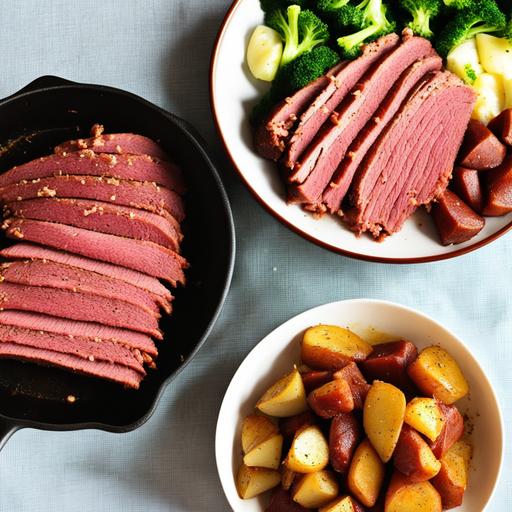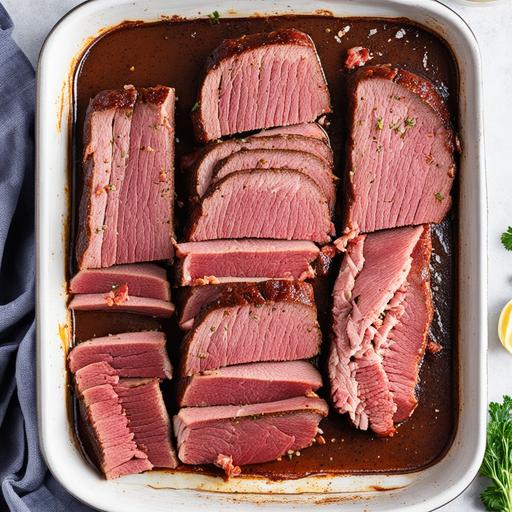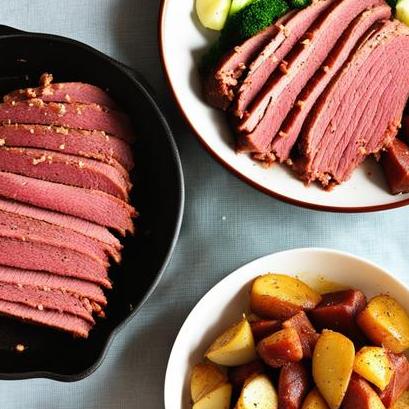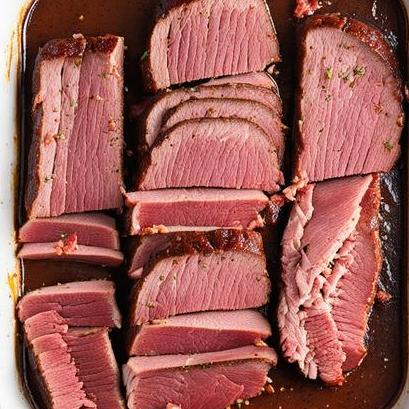
The Ultimate Guide To Corned Beef Oven Recipe
Unveiling the Secrets of this Flavorful Culinary Delight
Corned beef is a classic comfort food that has been enjoyed by many for generations. This flavorful and tender meat has a rich history and a unique cooking process that transforms a tough cut of beef into a melt-in-your-mouth delight. In this comprehensive guide, we will take a deep dive into the intricate world of corned beef oven recipe, exploring the food science behind its preparation, culinary details, selection tips, cleaning techniques, step-by-step preparation process, essential tips and tricks, popular variations, effective doneness checks, and how to avoid overcooking or undercooking it. So, let’s embark on this gastronomic journey and unlock the secrets to achieving the perfect corned beef!
Understanding the Food Science Behind Corned Beef
To truly appreciate corned beef, it’s crucial to understand the food science that makes it so unique. Corned beef gets its distinctive taste from the curing process; the beef is soaked in a brine solution containing salt, sugar, and various spices. This brine acts both as a preservative and a flavor enhancer, penetrating the meat and infusing it with a harmonious blend of savory and aromatic notes.
The salt in the brine plays a vital role in denaturing the proteins in the beef, which helps to tenderize it. Additionally, the sugar in the brine helps balance out the saltiness and adds a subtle hint of sweetness to the final product. The spices used in the brine, such as peppercorns, mustard seeds, and coriander, contribute to the complex flavor profile of the corned beef.
Selecting the Perfect Cut of Beef

When it comes to corned beef, the choice of beef cut is crucial to achieve the desired texture and taste. While traditional recipes call for brisket, you can also opt for other cuts, such as bottom round or eye round, depending on your preferences.
When selecting the beef, choose well-marbled cuts as they tend to be more tender and flavorful. Look for cuts with a good balance of fat and lean meat, ensuring that the marbling runs evenly throughout. Remember, the quality of the meat will greatly influence the end result of your corned beef, so choose wisely.
Cleaning and Preparing the Meat

Before embarking on the corned beef journey, it is important to clean and prepare the meat to ensure optimal results. Start by removing the beef from its packaging and rinsing it under cold running water. This helps remove any excess salt or brine solution, preventing the final dish from becoming overly salty.
After rinsing, pat the beef dry with paper towels. This step is crucial as excess moisture can interfere with the curing process and prevent the flavors from fully infusing into the meat. Once dry, place the beef on a clean cutting board and proceed to trim any excess fat or silver skin. Trimming the fat helps prevent the meat from becoming greasy as it cooks and ensures a more visually appealing final dish.
Essential Tips and Tricks for Flavorful Corned Beef

Preparing corned beef to perfection requires attention to detail and a few insider tips. Here are some essential tips and tricks that will elevate your corned beef oven recipe:
1. Soaking for Desalting (Optional Step)
If you prefer a milder flavor profile, you can choose to soak the beef in fresh water for a few hours or overnight to reduce the saltiness. This step is particularly helpful if the corned beef is labeled as "extra salty" or if you have a low-sodium diet. However, make sure not to oversoak the meat, as it can compromise the intended flavors.
2. Marinating for Enhanced Flavor
To add an extra layer of flavor, consider marinating the beef in a mixture of your favorite herbs, spices, and even a splash of beer or apple cider vinegar. This step infuses the meat with additional aromatics, resulting in a robust and tantalizing taste.
3. Low and Slow Cooking
Corned beef demands a gentle and slow cooking process to achieve the perfect tenderness. Ensure you preheat your oven to a low temperature, around 300°F (150°C), allowing the meat to cook slowly and evenly. This slow cooking process breaks down the tough muscle fibers and collagen, transforming them into melt-in-your-mouth goodness.
4. Basting for Moisture Retention
To prevent the meat from drying out during the cooking process, basting is key. Every 30 minutes, use a baster or spoon to drizzle some of the flavorful cooking liquid over the beef. This not only enhances the taste but also helps retain moisture, resulting in a succulent and juicy corned beef.
Popular Variations to Explore

While traditional corned beef recipes are delicious on their own, why not explore some popular variations that bring unique flavors to the table? Here are a few exciting ideas to try:
1. Mustard-Glazed Corned Beef
For an extra zing of flavor, consider glazing your corned beef with a tangy mustard sauce. Simply mix Dijon mustard, honey, brown sugar, and a squeeze of lemon juice, then brush it generously over the beef during the final stages of cooking. The glaze forms a delectable crust and imparts a delightful mustardy kick to the dish.
2. Guinness-Infused Corned Beef
Add a touch of Irish inspiration to your corned beef by incorporating a generous splash of Guinness beer into the cooking liquid. The deep, malty flavors of the stout complement the spices in the brine and lend a distinct richness to the meat.
3. Asian-Inspired Corned Beef
For an exotic twist, experiment with Asian flavors by infusing the corned beef with soy sauce, ginger, garlic, and star anise. These bold ingredients add an intriguing depth of flavor and create a fusion of cuisines that is sure to impress your taste buds.
Checking for Doneness – The Perfect Balance
Achieving the ideal level of doneness in your corned beef is crucial to ensure a tender and flavorful outcome. You want the meat to be cooked to perfection, but not overcooked or undercooked.
To gauge the doneness, gently insert a meat thermometer into the thickest part of the beef. For the most tender result, aim for an internal temperature between 195°F (90°C) and 205°F (96°C). At this temperature, the collagen breaks down, resulting in melt-in-your-mouth tenderness.
Avoiding Overcooking or Undercooking
Overcooking or undercooking corned beef can be disappointing, but fear not! By following a few simple guidelines, you can ensure your corned beef turns out ideally cooked every time:
1. Keep an Eye on the Temperature
Pay close attention to the internal temperature of the beef, using a reliable meat thermometer. This ensures that you achieve the desired level of doneness without risking the meat becoming tough or dry.
2. The Fork Test for Tenderness
If you don’t have a meat thermometer handy, you can assess the tenderness using the classic fork test. Carefully insert a fork into the beef, and if it easily slides in and out, the meat is tender and done. If it meets resistance, allow the meat to cook for a little longer until it reaches the desired tenderness.
3. Resting Period for Juiciness
Once you’ve deemed the corned beef perfectly cooked, don’t rush to slice into it just yet. Allow the meat to rest for about 15-20 minutes to allow the juices to redistribute. This resting period ensures the final outcome is juicy and moist.
Mouthwatering Corned Beef Oven Recipe
Without further ado, let’s delve into a mouthwatering corned beef oven recipe that encompasses all the aspects we’ve covered so far.
Ingredients:
-
3-4 pounds (1.4-1.8 kg) of corned beef brisket
-
1 gallon (4 liters) of water
-
1 cup (240 ml) of kosher salt
-
1/2 cup (120 ml) of brown sugar
-
2 tablespoons (30 ml) of pickling spice
-
4 garlic cloves, minced
-
1 medium-sized onion, roughly chopped
-
4 medium-sized carrots, peeled and chopped
-
4 medium-sized potatoes, scrubbed and quartered
-
1 small cabbage, cut into wedges
Instructions:
-
In a large stockpot, combine the water, kosher salt, brown sugar, pickling spice, minced garlic, and chopped onion. Stir well until the salt and sugar dissolve completely. This forms the brine.
-
Submerge the corned beef brisket in the brine, ensuring it is fully covered. Place the pot in the refrigerator and let the beef soak in the brine for at least 5 days, turning it occasionally to ensure even curing.
-
Once the beef is sufficiently cured, preheat your oven to 300°F (150°C).
-
Remove the beef from the brine and rinse it thoroughly under cold running water to remove any excess salt.
-
Place the corned beef in a large roasting pan, fat side up.
-
Add enough water to the roasting pan to reach a depth of about 1 inch (2.5 cm).
-
Cover the pan tightly with foil and place it in the preheated oven.
-
Allow the beef to cook for approximately 3 hours. After 2 hours of cooking, add the chopped carrots and quartered potatoes to the roasting pan.
-
Continue cooking for another hour or until the meat is fork-tender and the vegetables are cooked through.
-
In the final 20 minutes of cooking, add the cabbage wedges to the pan, tucking them between the meat and vegetables.
-
Once fully cooked, remove the pan from the oven and let the corned beef rest for about 15-20 minutes.
-
Transfer the beef to a cutting board and slice it against the grain into thin, tender slices.
-
Arrange the sliced corned beef on a serving platter, surrounded by the deliciously roasted vegetables.
-
Serve hot and enjoy!
The Magic of Corned Beef Oven Recipe Unveiled
Now that you have unlocked the secrets of corned beef oven recipe, armed with the knowledge of the food science, culinary details, selection tips, cleaning techniques, preparation process, essential tips and tricks, popular variations, and effective doneness checks, you are ready to embark on a culinary adventure. Whether it’s for St. Patrick’s Day, a special occasion, or simply to indulge in a comforting meal, corned beef prepared using this comprehensive guide is sure to impress your family and friends with its flavorsome taste and melt-in-your-mouth tenderness.
So, gather your ingredients, put on your apron, and let the tantalizing aromas fill your kitchen as you prepare a feast fit for royalty. With this ultimate guide by your side, you can confidently master the art of corned beef oven recipe and savor every mouthful of this beloved comfort food. May your corned beef endeavors leave your taste buds singing with delight and your heart filled with a sense of culinary accomplishment. Happy cooking!
Sources
FAQS On Corned Beef Oven Recipe
What Is The Best Cut Of Beef To Use For Corned Beef Oven Recipe?
The best cut of beef for corned beef oven recipe is usually brisket. Brisket is a tough, flavorful cut of beef that responds well to slow cooking methods such as roasting in the oven. Other cuts of beef, such as round or chuck, can be used for corned beef as well, but they may not be as tender or flavorful as brisket.
Do I Need To Soak The Corned Beef Before Cooking It?
Yes, it is recommended that you soak the corned beef before cooking it. This will help to remove some of the excess salt that is used in the curing process. Soaking the corned beef in water for several hours (or overnight) can also help to make it more tender.
How Long Should I Cook Corned Beef In The Oven?
The cooking time for corned beef in the oven will depend on the size and thickness of the cut of meat. Generally, you should plan on cooking the corned beef for 3-4 hours in a preheated 300°F oven. You can also use a meat thermometer to ensure that the internal temperature of the corned beef reaches 160°F.
What Are Some Good Seasoning Options For Corned Beef Oven Recipe?
Some popular seasoning options for corned beef include mustard, brown sugar, garlic, and black pepper. You can also use a spice blend specifically designed for corned beef, which typically includes ingredients such as coriander, allspice, and bay leaves.
Can I Add Vegetables To The Corned Beef When Cooking It In The Oven?
Yes, adding vegetables such as potatoes, carrots, and cabbage can be a great way to make a complete meal out of the corned beef oven recipe. Vegetables can be added to the roasting pan with the corned beef during the last hour or so of cooking, depending on how tender you want them to be. Make sure to toss the vegetables with some oil or butter and seasonings before roasting them in the oven.



